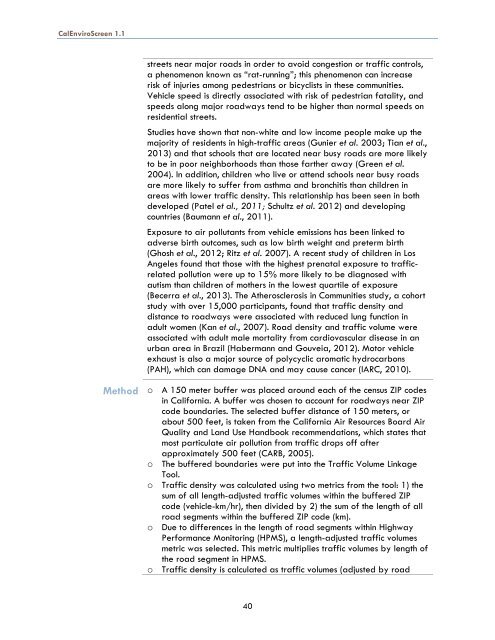CalEnviroscreen Version 1.1 - OEHHA - State of California
CalEnviroscreen Version 1.1 - OEHHA - State of California
CalEnviroscreen Version 1.1 - OEHHA - State of California
Create successful ePaper yourself
Turn your PDF publications into a flip-book with our unique Google optimized e-Paper software.
CalEnviroScreen <strong>1.1</strong><br />
streets near major roads in order to avoid congestion or traffic controls,<br />
a phenomenon known as “rat-running”; this phenomenon can increase<br />
risk <strong>of</strong> injuries among pedestrians or bicyclists in these communities.<br />
Vehicle speed is directly associated with risk <strong>of</strong> pedestrian fatality, and<br />
speeds along major roadways tend to be higher than normal speeds on<br />
residential streets.<br />
Studies have shown that non-white and low income people make up the<br />
majority <strong>of</strong> residents in high-traffic areas (Gunier et al. 2003; Tian et al.,<br />
2013) and that schools that are located near busy roads are more likely<br />
to be in poor neighborhoods than those farther away (Green et al.<br />
2004). In addition, children who live or attend schools near busy roads<br />
are more likely to suffer from asthma and bronchitis than children in<br />
areas with lower traffic density. This relationship has been seen in both<br />
developed (Patel et al., 2011; Schultz et al. 2012) and developing<br />
countries (Baumann et al., 2011).<br />
Exposure to air pollutants from vehicle emissions has been linked to<br />
adverse birth outcomes, such as low birth weight and preterm birth<br />
(Ghosh et al., 2012; Ritz et al. 2007). A recent study <strong>of</strong> children in Los<br />
Angeles found that those with the highest prenatal exposure to trafficrelated<br />
pollution were up to 15% more likely to be diagnosed with<br />
autism than children <strong>of</strong> mothers in the lowest quartile <strong>of</strong> exposure<br />
(Becerra et al., 2013). The Atherosclerosis in Communities study, a cohort<br />
study with over 15,000 participants, found that traffic density and<br />
distance to roadways were associated with reduced lung function in<br />
adult women (Kan et al., 2007). Road density and traffic volume were<br />
associated with adult male mortality from cardiovascular disease in an<br />
urban area in Brazil (Habermann and Gouveia, 2012). Motor vehicle<br />
exhaust is also a major source <strong>of</strong> polycyclic aromatic hydrocarbons<br />
(PAH), which can damage DNA and may cause cancer (IARC, 2010).<br />
Method o A 150 meter buffer was placed around each <strong>of</strong> the census ZIP codes<br />
in <strong>California</strong>. A buffer was chosen to account for roadways near ZIP<br />
code boundaries. The selected buffer distance <strong>of</strong> 150 meters, or<br />
about 500 feet, is taken from the <strong>California</strong> Air Resources Board Air<br />
Quality and Land Use Handbook recommendations, which states that<br />
most particulate air pollution from traffic drops <strong>of</strong>f after<br />
approximately 500 feet (CARB, 2005).<br />
o The buffered boundaries were put into the Traffic Volume Linkage<br />
Tool.<br />
o Traffic density was calculated using two metrics from the tool: 1) the<br />
sum <strong>of</strong> all length-adjusted traffic volumes within the buffered ZIP<br />
code (vehicle-km/hr), then divided by 2) the sum <strong>of</strong> the length <strong>of</strong> all<br />
road segments within the buffered ZIP code (km).<br />
o Due to differences in the length <strong>of</strong> road segments within Highway<br />
Performance Monitoring (HPMS), a length-adjusted traffic volumes<br />
metric was selected. This metric multiplies traffic volumes by length <strong>of</strong><br />
the road segment in HPMS.<br />
o Traffic density is calculated as traffic volumes (adjusted by road<br />
40















